Tianjin
![]()
The title of this article is ambiguous. For the former Chinese vehicle manufacturers, see Tianjin Auto Works and Tianjin Huali Motor.
Tianjin (Chinese 天津市, Pinyin Tiānjīn shì, W.-G. T'ien-chin - "literally sky ford city", obsolete after Post Tientsin, Rod Tientsin) is an important port city in the People's Republic of China. The city's total administrative area covers 11,943 square kilometres. Tianjin is one of the four direct government cities in China, i.e. directly subordinate to the central government in Beijing, and thus has the same status as a province.
The entire administrative area of Tianjin has 12.94 million inhabitants (as of the 2010 census). Of these, 9.5 million are registered permanent residents (戶口 / 户口, hùkǒu) and 1,0 million temporary residents (流動人口 / 流动人口, liúdòng rénkǒu) with temporary residence permits (暫住證 / 暂住证, zànzhùzhèng). Taking the core city with its high building density and closed town form as a basis, Tianjin has 3.8 million people as primary residents. The metropolitan area has 6.4 million inhabitants, including suburbs. (As of 2007)
The city is an industrial centre, transport hub and cultural centre of the region with universities, colleges, museums and architectural monuments. The administrative area of Tianjin does not represent a coherent urban area, but - with its dominant rural settlement structure - would be more comparable to a small province. Historically, Tianjin was the capital of the former Zhili province.
Geography
Geographical position
The city is located in the north of the country southeast of Beijing five meters above sea level, at the confluence of the Hai He River with the Imperial Canal. It borders the government-owned city of Beijing and the province of Hebei.
The administrative city area has a surface area of 11,943 square kilometres. This corresponds roughly to the land area of Upper Austria and is slightly smaller than Schleswig-Holstein. Of this area, 167.8 km² (1.4%) belong to the core city (high building density and closed village form) and 11,775.2 km² (98.6%) to suburbs and areas with rural settlement structure.
It is 120 kilometers from Tianjin city center to Beijing. Bohai Bay is located 50 kilometers east of Tianjin. The Hai He River flows through the city to Bohai Bay.
The total administrative area of the non-governmental city of Tianjin has a north-south extension of 186 kilometers and an east-west extension of 101 kilometers. The largest cities are: Tianjin population 3,755,249; Tanggu population 564,498; Hangu population 227,358; Gangdong population 141,741; Yangliuqing population 77,768; Xianshuigu population 75,366; and Yangcun population 64,908. (As of January 1, 2007)
Geology
The North China Plain (Great Plain), in which Tianjin is located, is geologically an intrusion field that was later filled in by the delta formations of the North China Rivers. It consists of alluvial loess and sands brought by the rivers from the western mountainous countries. The plain is thus a continuation of the loess land.
It also resembles the neighbouring Loess Hills in terms of climate - hot humid summers and dry cold winters with dust storms - and plant geography - parkland with steppe-like features. The North China Plain represents a huge alluvial cone that the Huang He, the most mud-rich river on earth, has piled up over many millennia and whose foothills reach the Yellow Sea north and south of the Shandong Peninsula. The area is subject to strong tectonic stresses that repeatedly cause earthquakes. The cause is the slow northward shift of the Indian continental plate into the Eurasian continental plate. The speed of plate tectonics is on average about four centimeters per year.
On July 28, 1976, the most severe earthquake of the 20th century occurred in Tangshan, 120 kilometers east of Tianjin (see Tangshan 1976 quake). It had a magnitude of 8.2 on the Richter scale. The official figure given by the government of the People's Republic of China for the number of dead is 242,419, but some estimates give a figure as high as 800,000 dead, 25,000 of them in Tianjin; the magnitude is also officially given as only 7.8. The quake caused severe damage in Tianjin and other cities in the region.
City breakdown
The administrative area of the city is divided into 15 boroughs and one "new" borough.
The core city is divided into six boroughs:
- Heping (和平区, Hépíng Qū)
- Hexi (河西区 Héxī Qū),
- Hebei (河北区, Héběi Qū)
- Nankai (南开区, Nánkāi Qū)
- Hedong (河东区, Hédōng Qū).
- Hongqiao (红桥区, Hóngqiáo Qū)
Four other boroughs are located in the close vicinity of the core city:
- Jinnan (津南区, Jīnnán Qū)
- Dongli (东丽区, Dōnglì Qū)
- Xiqing (西青区, Xīqīng Qū)
- Bichen (北辰区, Běichén Qū)
Five boroughs and the new Binhai borough are located in the rural areas outside the core city:
- Binhai (滨海新区, Bīnhaǐ Xīnqū).
- Baodi (宝坻区, Bǎodǐ Qū) - county until 2001.
- Wuqing (武清区, Wǔqīng Qū) - circle until 2000
- Jizhou (蓟州区, Jìzhōu Qū) - Ji County until 2016
- Jinghai (静海区, Jìnghǎi Qū) - county until 2015
- Ninghe (宁河区, Nínghé Qū) - county until 2015
See also List of Tianjin Municipalities
Climate
Although Tianjin is only about 50 kilometers from the coast, it has a temperate continental climate due to its location in the west wind belt, which means warm, humid summers and cold, dry winters. Annual rainfall averages 560.2 millimeters, of which about 61 percent falls in July and August.
The average annual temperature is 13.0 °C. The warmest month is July with 30.7 °C mean daily maximum and 22.7 °C mean nightly minimum temperature. The coldest month in the Tianjin area is January with 1.6 °C mean daily maximum and -7.7 °C mean nightly minimum temperature.
| Tianjin | ||||||||||||||||||||||||||||||||||||||||||||||||
| Climate diagram | ||||||||||||||||||||||||||||||||||||||||||||||||
| ||||||||||||||||||||||||||||||||||||||||||||||||
| Monthly average temperatures and precipitation for Tianjin
Source: | ||||||||||||||||||||||||||||||||||||||||||||||||||||||||||||||||||||||||||||||||||||||||||||||||||||||||||||||||||||||||||||||||||||||||||||||||||||||||||||||||||||||||||||||||||||||||||||||||
Winter brings temperatures as low as -20 degrees Celsius and an icy wind blowing from the plains of Inner Mongolia. Summer (June to August) is hot and humid with temperatures up to 35 degrees Celsius, and the short spring (April and May) is dry but windy. In autumn (September and October) the weather is dry and mild.
When the wind comes from the north, it can get very cold in winter and there are often sandstorms in spring. The highest temperature ever recorded was officially measured on 4 July 1972 at 39.7 °C, the lowest on 22 February 1966 at -22.9 °C.

Satellite image of Tianjin, 2002
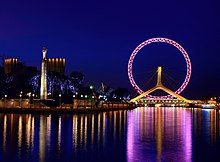
Tianjin Eye - the 120 m high Ferris wheel above the Yongle Bridge at Hai He, 2009
History
Origin and further development
The history of the place from a fishing village to a modern trading metropolis goes back many centuries and is strongly linked to the history of Beijing. From the 11th to the 14th century, Tianjin was a small seaport that was highly important to the imperial court as a grain warehouse. Later, when originally independent kingdoms in southern China were subjugated, the city was a port of passage for tribute and supplies from those kingdoms to the capital. During the Yuan Dynasty, the Imperial Canal running through Tianjin was finally completed or extended to Dadu (Beijing) in the 13th century.
The city received the name Tianjin from Emperor Zhudi during the early years of the Ming Dynasty (1368-1644). At this time, it received its pre-eminence as a port for Beijing and a heavily fortified garrison city. Later, under the Qing Dynasty (1644-1911), it became a thriving trading center (especially for sea salt).
Foreign concessions
In the 19th century, the city came to the attention of seafaring powers from the West. As a result of China's defeat in the First Opium War, Britain forced the opening of five southern Chinese port cities to its trade through the Treaty of Nanking in 1842 (see Unequal Treaties). On the pretext - Chinese officials had seized the British-flagged Lorcha Arrow on October 8, 1856 - the United Kingdom again declared war on China. European gunboats and warfare also proved superior in this so-called Second Opium War, also known as the "Arrow War," which France joined on the British side for comparable, trade-political motives. (See Gunboat Policy) The Treaty of Tianjin, signed on June 27, 1858, gave the victorious Europeans the right to establish further concessions on the Chinese mainland. In return, the treaty provided for the withdrawal of the British from Tianjin (historical transliteration Tientsin) and the evacuation of Dagu Fortress, 60 kilometers southeast of the city. China subsequently refused to implement the treaty. As a result, the British opened the second phase of the Second Opium War in June 1859 with a renewed attack on Dagukou. Only after the campaign in 1860, during which an invading army led by Lord Elgin reduced the Old Summer Palace in Peking to rubble, did Prince Gong, representing Emperor Xianfeng who had fled to Manchuria, confirm the terms of the treaty. In the so-called Beijing Convention of 18 October 1860, they were supplemented by further points, in particular the opening of the port of Tianjin itself, further reparations and cessions of territory to Great Britain and Russia.
On this basis, first Great Britain and France (as already in the 1840s in Shanghai) established two concession areas in Tianjin southeast of the walled city, from which northern China could be opened up for international trade. Due to the growing importance of the city as an important centre of trade and communication (as "Shanghai of the North") not far from Beijing, other colonial powers (Russia, Japan, the German Empire, Austria-Hungary, Belgium and Italy) followed suit until 1895/1900, negotiating follow-up treaties (see Unequal Treaties) and establishing separate concessions along the Hai He by means of diplomatic but also military pressure. These foreign enclaves - built in the respective national architectural style - had their own infrastructure and administration. The concessions shaped Tianjin's development into a modern city, but equally symbolized China's quasi-colonial penetration. One of the main roads that ran through these European neighborhoods (today's "Jiefang Beilu", 解放北路 - "literally Liberation Road North") carried sectional names representing the respective dominions: "Rue de la France", "Victoria Road", and "Wilhelm Road" (or after 1919, "Woodrow Wilson Road"). In 1900, Tianjin was the scene of fierce fighting in the Boxer Rebellion, as a result of which the city's geopolitical importance also grew with increased foreign garrisons. Some of the concessions continued to exist de jure until 1943.
In the context of the 2008 Olympic Games in Beijing, parts of the former Italian concession areas were revitalized as a tourist attraction. A similar project on the Austrian concession area is in preparation.
Uprisings and Japanese Occupation
Tensions between the local population and the privileged foreigners erupted, among other things, in the events of Tianjin on 21. June 1870, the so-called Tianjin Massacre (天津教案, Tiānjīn jiào'àn, historical spelling Tientsin Massacre), when an angry Chinese crowd attacked the French orphanage of Notre-Dame-des-Victoires (望海樓教堂 / 望海楼教堂 - "Wanghailou Church"). This was prompted by rumors of Chinese orphans being bought or taken there and even cases of cannibalism on the part of the European nuns. Despite efforts by Chinese officials to calm the people, the situation escalated, as a result of which the French consul, nuns, priests, other foreigners and Chinese Christians were killed. It is estimated that a total of about 60 victims were killed. Twenty Chinese were then beheaded and the prefect banished from the city.
Although, or rather because, Tianjin (historically Tientsin) was effectively a protectorate of the European foreign powers, the city rose to become the second largest trade and communications center in China after Shanghai.
As the center of secret resistance against the Europeans, the city was the scene of fierce fighting in the Boxer Rebellion in the summer of 1900. From here, the expeditionary force formed by soldiers from eight nations (2066 soldiers in total) set out to relieve the legation quarter in Beijing besieged by insurgents and regular Imperial Chinese troops on June 10, 1900, but failed to break through and even fell on the defensive in Tianjin in the meantime. With the landing of larger foreign troop contingents (mainly British-Indian, Russian, Japanese, and U.S. units) and their arrival in Tianjin on July 14, 1900, communication with the coast was restored. The concessions saw the deployment of the now significantly reinforced multinational army (some 20,000 troops), which reached Beijing on 13 August 1900 and liberated the trapped foreigners. Major parts of the old city, including Tianjin's city walls, were destroyed during the fighting but were soon rebuilt in European style. Eventually, the foreigners demolished the walls and the old Chinese quarter in order to have a better view of the residents.
A prominent resident in Tianjin at the time of the Boxer War was Herbert Hoover, the later (31st) President of the United States, who was then a mining engineer in China. Having survived weeks of shelling of foreign concessions by the "Boxers" with his family, he was able to be useful as a local expert to the U.S. Marines who had followed. For Hoover, Tianjin was a "universal city - like a world in miniature with all its nationalities, its architectural styles, and its cuisines."
As a result of the Boxer Rebellion and its suppression, the city's geopolitical importance grew due to increased foreign garrisons.
From 1900 to 1909, the city was administered by an international commission representing those powers that had branches in Tianjin: Russia, Great Britain, France, Belgium, Japan, Italy, Austria-Hungary and the German Empire.
In 1906, the first tramway was put into operation in Tianjin.
After being expelled from the Forbidden City and placed in the custody of the Japanese legation, Aisin Gioro Pu Yi, the last emperor of the Qing Dynasty, moved to Tianjin on February 23, 1925. Here he resided in a stately villa in the Japanese concession until 1932 and took an active part in the social life of the cosmopolitan port city.
In 1927, Tianjin received the status of an independent city at the provincial level (直轄市 / 直辖市 - "Government-Independent City").
With the beginning of the Second Sino-Japanese War as a result of the so-called Marco Polo Bridge (Lugouqiao) Incident on July 7, 1937 near Beijing (then Peiping), Japanese troops, who had already occupied Manchuria in 1931 and already controlled large parts of northern China (see Manchurian Crisis), advanced southward across the Great Wall at Shanhaiguan. On July 29, 1937, Tianjin-in particular Nankai University, adjacent to the Japanese concession and an active center of "anti-Japanese agitation" among the nationally conscious Chinese student body-was bombed by Japanese aircraft. The few, poorly led Chinese units could hardly offer any resistance against the superior strength of the Japanese army, so that the city was taken almost without a fight the following day and remained under Japanese occupation until the end of the war. The sovereign rights of the other colonial powers, with which Japan was not (yet) at war, were initially respected, so that the foreign concessions continued. However, with the Japanese blockade of the British concession in the summer of 1939, it soon became apparent that these could not be held militarily. Even before Japan entered the war against the USA and Great Britain, their garrisons withdrew from Tianjin in 1940.
The expansion of the Tianjin-Xingang seaport took place during this period.
The Japanese occupation lasted until August 15, 1945, when U.S. forces entered the city after Japan surrendered, ending World War II. In December 1946, the rape of Chinese women in Tianjin by American soldiers sparked protests in the city that culminated in a large demonstration on January 1, 1947. US troops subsequently withdrew from Tianjin in June 1947.
Communist period of government
Communist troops captured Tianjin on January 15, 1949, after a 29-hour battle during the civil war with Kuomintang forces. After the Communist takeover, Tianjin initially remained an independent provincial-level municipality in China. In 1958, Tianjin became the capital of Hebei Province and was granted the status of a government-owned city in 1967.
According to official figures, 23,938 people died in Tianjin as a result of the Tangshan earthquake in 1976, and the city suffered severe destruction. Since the implementation of the economic reforms adopted by the Chinese government in 1978, the economy of Tianjin has shown a high stable growth until today, which led to a rapidly growing prosperity of large parts of the population.
The biggest problems facing the city today, due to failed modern urban planning policies, are growing immigration, air pollution caused by unfashionable factories, and sprawling traffic, which contributes to poor air quality and brings the city to the brink of gridlock. But a renaissance is also taking place in many social problems that were thought to have been eliminated forever by the communists after 1949. Unemployment, drug abuse and prostitution are showing strong growth.
On 12 August 2015, serious explosions occurred at the port in Tianjin (in Binhai) in a warehouse for hazardous materials. 173 people died and 797 were injured.
Population development
While Tianjin's population has doubled since the 1950s, it has remained relatively constant since the early 1990s, partly due to the introduction of the one-child policy. In the core city (high building density and closed place form) live 3.8 million people with main residence (2007). The population density is 22,379 inhabitants per square kilometre.
The entire administrative area of the Government Unified City has a population of 10.5 million (2007). Of these, 9.5 million are registered permanent residents (戶口 / 户口, hùkǒu) and 1,0 million temporary residents (流動人口 / 流动人口, liúdòng rénkǒu) with temporary residence permits (暫住證 / 暂住证, zànzhùzhèng). The population density is 879 inhabitants per square kilometre. The urbanization rate for the entire administrative area of Tianjin is given as 72 percent.
Anyone wishing to stay in the city for more than three days must report to the Public Security Office and is registered there. The applicant then receives a temporary residence permit for three months, which must be renewed at the end of the period. A certificate from the place of origin must be presented to the office confirming that the person is registered there.
Of Tianjin's 9,848,731 residents identified in the 2000 census, 97.29% were Han Chinese, 1.75% Muslim Hui Chinese, 0.57% Manchu, 0.12% Mongolian, and 0.11% Korean. Of China's 56 officially recognized nationalities, only four are not represented among Tianjin's residents.
The following overview shows the population figures for the core city (excluding the suburban belt). Listed are the registered residents with main residence in Tianjin.
|
|
Development of the housing situation
The supply of housing is still precarious, although according to official figures from the city government the living space per capita has tripled since 1957. The communist city government had by no means been inactive; since the early 1950s, housing and living conditions had already been improved in the city districts with inadequate standards, and many new residential areas had been built. In China, it is expected that up to 350 million more rural residents will flock to the urban agglomerations in the coming decades.
For some years now, there has been a tendency to build large-scale new housing estates in conjunction with landscaped parks, golf courses and man-made lakeside lots. These buildings are usually above the normal standard, designed for a well-off middle class and hardly affordable for the average wage earner. One particular project is the construction of an ecologically sustainable large housing estate. Around 24 kilometres south of the city centre, around a 7 kilometre long and 3 kilometre wide artificial lake, an attempt is being made to counteract the monotony of a dormitory town serially populated with high-rise buildings with something different. About one third of the area east of the suburb of Jinghai, which covers several square kilometers, is to be supplied with renewable energy; otherwise, it will have an infrastructure suitable for everyday use and workplaces close to the city. The Chinese government has declared the project a reference project for future urbanizations. The first apartments will be ready for occupancy at the beginning of 2013, and everything is scheduled for completion by 2020.
The housing situation of the approximately one million residents with limited residence permits is significantly worse in contrast to the residents with main residence. Numerous migrants, mostly former farmers from China's rural regions, live on construction sites, in simple company dormitories or they rent a room from farmers on the periphery of the city. A large proportion of temporary residents live on the outskirts of the city because there is more space for self-built huts.
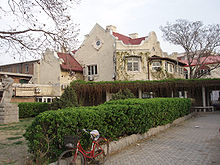
Machang Dao 馬場道 / 马场道, English Race Course Road - historic concession area of Britain, Hexi 2003.
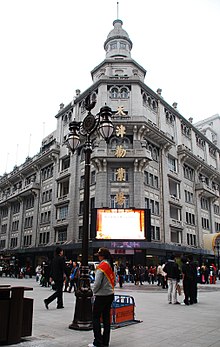
Traditional Tianjin department store Quànyè Chǎng 天津勸業場 / 天津劝业场, Heping 2010

Tianjin Jinwan Plaza for Chinese New Year, Heping 2011
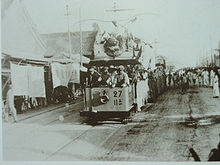
Tianjin's first tramway, 1906
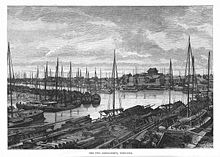
Historic port of Tianjin, 1887
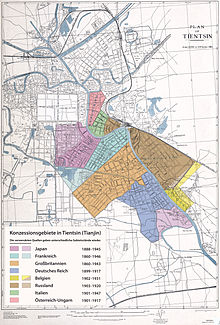
The concession areas in Tianjin, map 1942
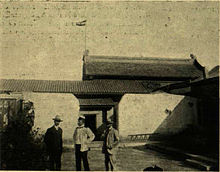
The Austro-Hungarian flag on the roof of the Austrian naval command, concession area 1903

Tientsin Club and Astor House Hotel, 1902
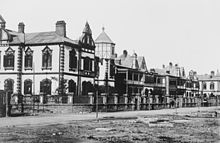
Wilhelm Street in Tianjin, 1898

Inauguration of the German war memorial in Tianjin, 1905
Questions and Answers
Q: What is the population of Tianjin?
A: The population of Tianjin is 11,760,000.
Q: How far away is Tianjin from Beijing?
A: The distance between Tianjin and Beijing is 137 kilometers.
Q: How long does it take to travel between Tianjin and Beijing?
A: It will take only half an hour to go from Tianjin to Beijing by the Beijing–Tianjin Intercity Railway.
Q: What industries are prominent in Tianjin?
A: The prominent industries in Tianjin include electronic information, automobile, metallurgical, chemical, biotechnology and modern medicine, new energy and environmental protection.
Q: How many universities are there in Tianjin?
A: There are 37 universities in Tianjin.
Q: What famous cuisine can be found in Tianjin?
A: One of the most famous cuisines in Tianjin is The Four Great Stews which includes chicken, duck, seafood, beef and mutton dishes. Additionally there are several famous snack items such as Goubuli (steamed buns with filling), Guifaxiang (twisted dough sticks) and Erduoyan (fried rice cakes).
Search within the encyclopedia